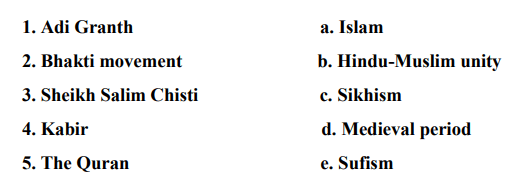DAV Class 7 SST Chapter 17 Question Answer Major Religions explores the solutions to the exercises given in the textbook We and Our World Book. These DAV Class 7 solutions of Social Science of Chapter 17 Major Religions provided at the end of the chapter will be a useful resource for Class 7 school exams.
Here at solutiongyan, we provide complete solutions of DAV Class 7 SST chapter 17 History of We and Our World Book. DAV Class 7 SST Chapter 17 Major Religions exercise contains 5 questions and the answers to them are provided in the DAV Class 7 SST Chapter 17 Question Answer.
These Solutions of DAV Class 7 Social Science Chapter 17 help to boost the writing skills of the students, along with their logical reasoning. Students can go through chapter 17 Major Religions solutions to learn an effective way of expressing their solutions in the exam.

DAV Class 7 History Chapter 17 Major Religions Solutions
DAV Class 7 Social Science Book question answer of Chapter 17 Major Religions is given below. Here DAV Class 7 SST chapter 17 Question Answer is provided with detailed explanation.
Highlights
Answer the following questions in brief
Answer the following questions
DAV Solutions For Class 7 SST of WE AND OUR WORLD Book is the best source for the students to self-analyse their performance. DAV Class 7 students are more likely to score good marks in the exams if they practise Dav Class 7 SST Chapter 17 Major Religions Question Answer regularly.
DAV Class 7 SST Chapter 17 Question Answer
A. Tick the correct option.
1. Who among the following was NOT a sufi saint?
Answer: Kabir
2. In which religion pilgrimage to ‘Haj’ is practised?
Answer: Islam
3. The Bhakti Movement originated in-
Answer: South India
4. Shakti saints did not oppose-
Answer: communal harmony
5. Who constructed the Akal Takht near the Golden temple?
Answer: Guru Har Gobind
B. Fill in the blanks.
1. The founder of Islam ___________ was born in ___________ in 570 CE.
2. Sikhism is based on ___________ tradition.
3. Gurudwara Harminder Sahib is situated in ___________.
4. ___________ took ideas of Bhakti to the north.
5. Alvars worshipped ___________ and Nayanars worshipped ___________
Answer: (1) Mohammad, Mecca (2) Gurus- shishya (3) Amritsar (4) Ramananada (5) Vishnu, Shiva.
C. Match the following:

Answer: (1) c (2) d (3) e (4) b (5) a.
D. Answer the following questions in brief.
1. How did the city of Amritsar take its name? Who constructed Gurudwara Harminder Sahib?
Answer: Guru Ram Das dug the holy tank known as Amritsar. The city of Amritsar takes its name from it. Guru Arjun Dev constructed Gurudwara Harminder Sahib.
2. When did Prophet Mohammad attain revelation and how?
Answer: At the age of forty, Mohammad got the light of revelation while meditating in a cave near Mecca and declared himself the Prophet of Allah.
3. What was the way to realise God according to Guru Nanak?
Answer: According to Guru Nanak believes in selfless and honest service of humanity in all forms is the only way to realise God.
4. Give the meaning of Bhakti and name four prominent Bhakti saints.
Answer: Bhakti means complete submission and devotion to God. Meera, Chaitanya, mahaprabhu Tulsidas, and Surdas are some of the prominent Bhakti Saint.
5. State the practices of Sufis which are similar to Hinduism or Buddhism.
Answer: Some of the practices among the Sufis were similar to Hinduism or Buddhism. e.g., penance, fasting, pranayam, good deeds and belief in equality among all, without any distinction of colour, caste or creed.
E. Answer the following questions.
1. Explain the teachings of Islam with special reference to its principles.
Answer: The teachings of Islam are based on these five principles:
- Every Muslim should always proclaim oneness of God i.e., Allah and Mohammad as his prophet on this earth.
- Every Muslim should offer prayers five times daily, and on Friday afternoon in a mosque with others collectively.
- One should give alms to the poor and needy.
- Every Muslim should keep fast i.e., roza during the day in the month of Ramzan from dawn to dusk.
- One should, if possible, go on a ‘Haj’ to Mecca at least once in a lifetime.
2. Mention the features of Islam that make it a humane religion.
Answer: The features of Islam that make it a human religion are given below:
- Islam rejects idol worship and elaborate rituals.
- It preaches that Allah punishes us for the bad deeds and rewards us for good deeds.
- It also propagates the concept of equality.
- It gives emphasis on giving alms to the poor.
- It gives emphasis on love and devotion to God and compassion towards all fellow human beings.
3. Explain the contribution of Guru Teg Bahadur and Guru Gobind Singh to Sikhism.
Answer: Guru Tegh Bahadur fought against the oppression by the Mughals. He inculcated courage among the Sikhs to fight against the atrocities of the Mughal rulers.
Guru Govind Singh gave impetus to the Sikh movement which culminated in the constitution of the Khalsa Panth at Anandpur popularly known as Takhat Sri Keshgarh Sahib in 1699. Thus, the community of the Sikhs, called the Khalsa Panth, became a political entirety.
4. State the importance of Bhakti movement in reforming and uniting the Indian society?
Answer: The Hindu society had been a prey to many evils such as caste system, inequality, superstitions, narrow mindedness. The Bhakti movement tried to reform the Hindu society by eliminating these evils. For this the Bhakti servants did a lot of work:
- All over India, they used local languages to preach their message.
- They condemned rigidities of casteism and taught lessons of love, devotion and equality.
- They discarded rituals and sacrifices to create oneness with God. They described all kinds of discriminations based on religion.
- They opposed the caste system, and superstitions narrow mindedness. They encouraged religious tolerance.
- Kabir and Nanak, the popular Bhakti saints, strongly preached Hindu, Muslim unity.
5. Enlist the similarities between Islam and Sikhism.
Answer: The similarities between Islam and Sikhism are:
- Both laid emphasis on one God or Almighty.
- Both preached that one should have pure heart and self-discipline to reach God.
- Both believed in equality and rejected all kinds of discriminations based on caste, religion or wealth.
- Both the religions propagated that to be one with God, one has to be egoless and denounce lust for worldly pleasures.

Thank u solution gyaan
For answers ????????????????
Thank you solution Gyan
For answer ❤️❤️❤️❤️????
Very good appp✨✨✨
Thanks a lot for your answer
The best
Solution gyan
Thanks you solution Gyan????????
Thank you sir too much helping your answer 200 percent correct
Best website to know about all DAVs answers of all subjects. Thanks to this website.
Thanks for the answers solutiongyan????????????
It is so help full for me.
East or west solution gyan is best..!
Thanks a lot….this website is very helpful for D.A.V. students ????????????